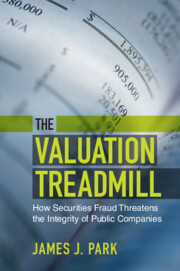Book contents
- The Valuation Treadmill
- The Valuation Treadmill
- Copyright page
- Dedication
- Contents
- Acknowledgments
- 1 Introduction
- 2 Xerox and the Pressure to Meet Projections
- 3 Penn Central and the Decline of Managerialism
- 4 Apple and the Controversy of Projections Litigation
- 5 Enron and Sarbanes–Oxley
- 6 Citigroup and the Financial Crisis of 2008
- 7 General Electric and the Problem of Earnings Management
- 8 The Future of Securities Fraud Regulation
- 9 Conclusion
- Notes
- Index
7 - General Electric and the Problem of Earnings Management
Published online by Cambridge University Press: 14 July 2022
- The Valuation Treadmill
- The Valuation Treadmill
- Copyright page
- Dedication
- Contents
- Acknowledgments
- 1 Introduction
- 2 Xerox and the Pressure to Meet Projections
- 3 Penn Central and the Decline of Managerialism
- 4 Apple and the Controversy of Projections Litigation
- 5 Enron and Sarbanes–Oxley
- 6 Citigroup and the Financial Crisis of 2008
- 7 General Electric and the Problem of Earnings Management
- 8 The Future of Securities Fraud Regulation
- 9 Conclusion
- Notes
- Index
Summary
78% of the surveyed executives would give up economic value in exchange for smooth earnings. Graham, Harvey & Rajgopal, 2005 Over the last twenty years, as memories of the crisis that spurred the passage of the Sarbanes–Oxley Act of 2002 (Sarbanes–Oxley) faded, public company securities fraud receded as a matter of national concern. The stock market losses arising out of the financial crisis of 2008 were only partly linked to securities fraud, and the slow economic recovery afterward did not generate many spectacular investor losses that could be firmly tied to a corporate misrepresentation. There is some evidence that companies responded to Sarbanes–Oxley by adopting more conservative financial reporting policies. Stronger internal controls may have been successful at checking obvious accounting rule violations.
Keywords
- Type
- Chapter
- Information
- The Valuation TreadmillHow Securities Fraud Threatens the Integrity of Public Companies, pp. 114 - 128Publisher: Cambridge University PressPrint publication year: 2022

